MAGIICAT I. The MgII Absorber–Galaxy
Catalog

The catalog is a compilation of the MgII
absorber–galaxy pairs in the literature with
spectroscopic galaxy redshifts. In Paper I, we describe
the surveys included, the methods for standardizing
absorption and galaxy properties, and tabulate the
data. Only isolated galaxies are included in Paper
I. See Paper VI below for group environments.
(Left) The relative locations of each galaxy
(points) and the associated background quasar (plus
sign) for a majority of the survey data included in
MAGIICAT.
MAGIICAT II. General Characteristics of the MgII
Circumgalactic Medium
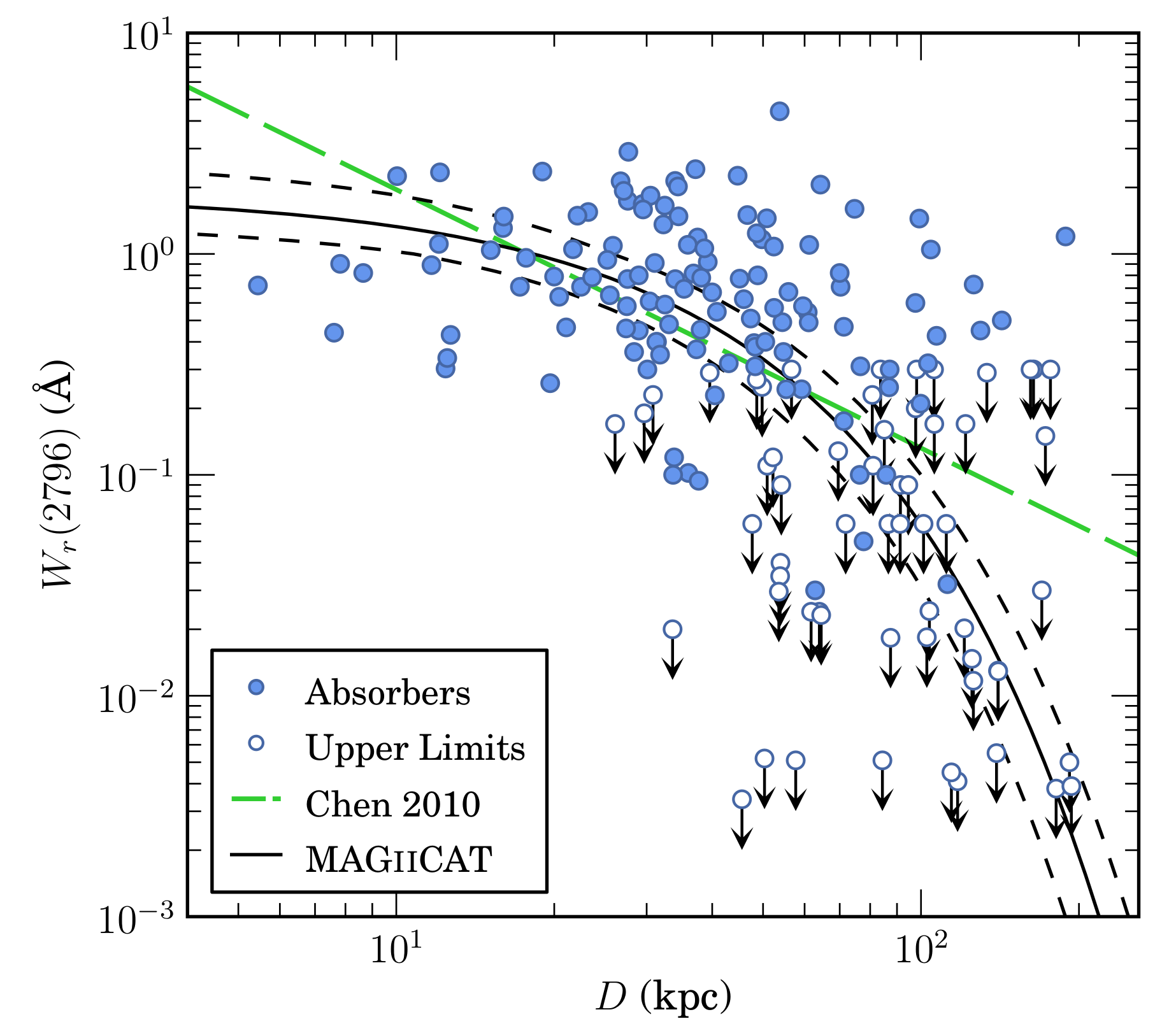
With the isolated galaxy sample, we investigated the
dependence of MgII absorption characteristics on host
galaxy properties. This work focused on equivalent
widths, covering fractions, and luminosity-scaled
absorption radii for various galaxy luminosities,
colors, impact parameters, and redshifts. The MgII
circumgalactic medium is more extended and has a larger
covering fraction around higher luminosity, bluer, and
higher redshift galaxies.
(Right) MgII equivalent width is anti-correlated
with quasar–galaxy impact parameter at the
7.9σ level and the dependence is fit well by a
log-linear relation.
The Self-Similarity of the Circumgalactic Medium
with Galaxy Virial Mass: Implications for Cold-Mode
Accretion
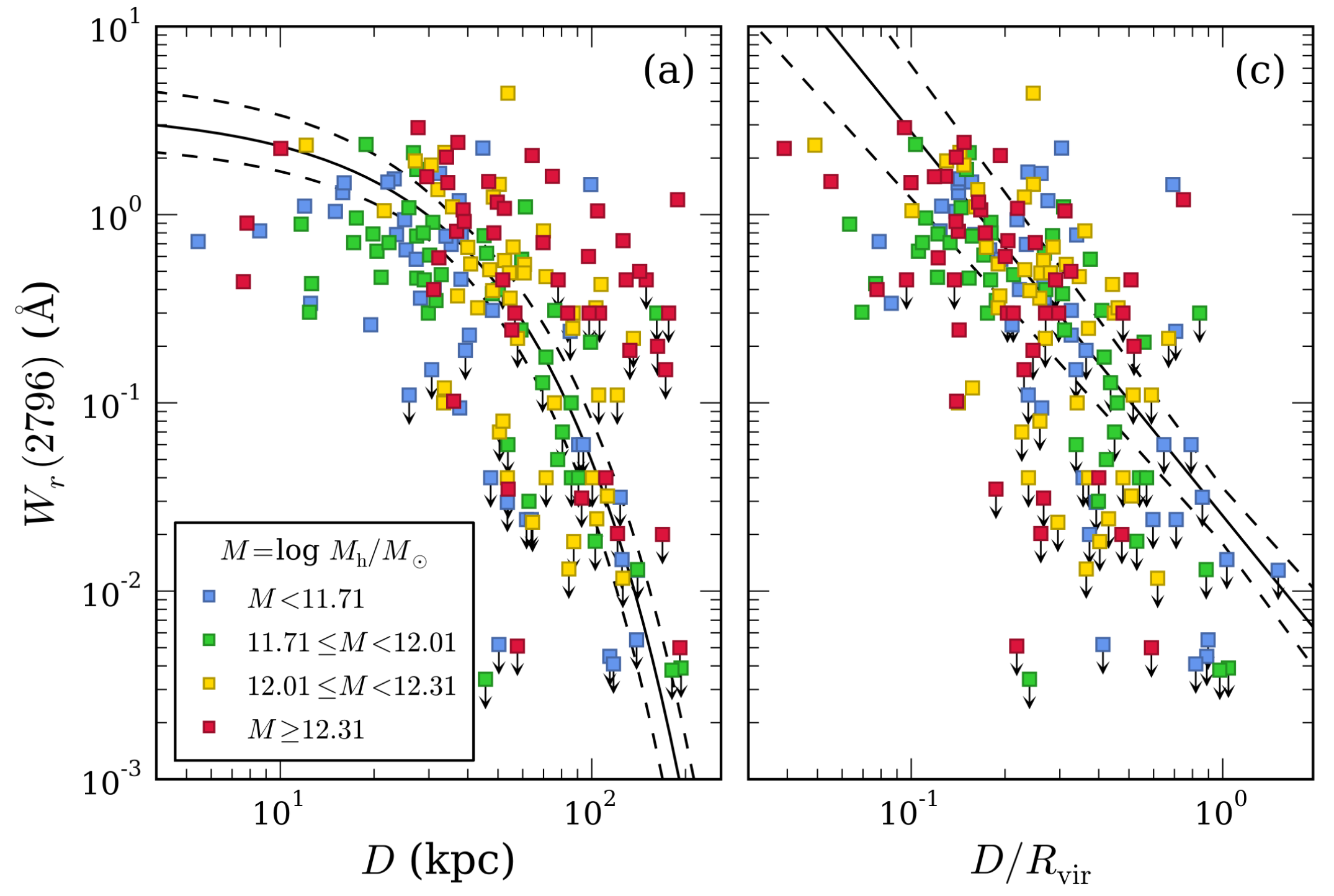
Using halo abundance matching, we obtained galaxy virial
masses and radii for MAGIICAT isolated galaxies and
studied the mass-dependence of equivalent widths and
covering fractions. The circumgalactic medium is
self-similar with halo mass. Constant covering fractions
with mass indicate that outflows or sub-halos contribute
to absorption in more massive galaxies despite the
prediction that cold mode accretion is quenched.
(Left) More massive galaxies have larger
equivalent widths at a given impact parameter than less
massive galaxies. This mass segregation vanishes when
normalizing impact parameter by the virial
radius.
MAGIICAT III. Interpreting Self-Similarity of the
Circumgalactic Medium with Virial Mass using MgII
Absorption

Following up on the self-similarity of the CGM with
mass, we found that MgII primarily resides within 0.3
Rvir regardless of halo mass and for all
equivalent width measurements. We also investigated the
dependence of MgII on the cooling radius, finding that
the cooling radius is a poor indicator of MgII
absorption strength. The presence of absorption outside
this radius suggests that cool/warm CGM gas does not
solely originate from fragmentation and condensation out
of the hot CGM. Our halo abundance matching methods are
detailed in Appendix A.
(Right) The MgII equivalent width is constant
with mass, contrary to previous absorber–galaxy
cross-correlation studies.
MAGIICAT IV. Kinematics of the Circumgalactic Medium
and Evidence for
Quiescent Evolution around Red
Galaxies
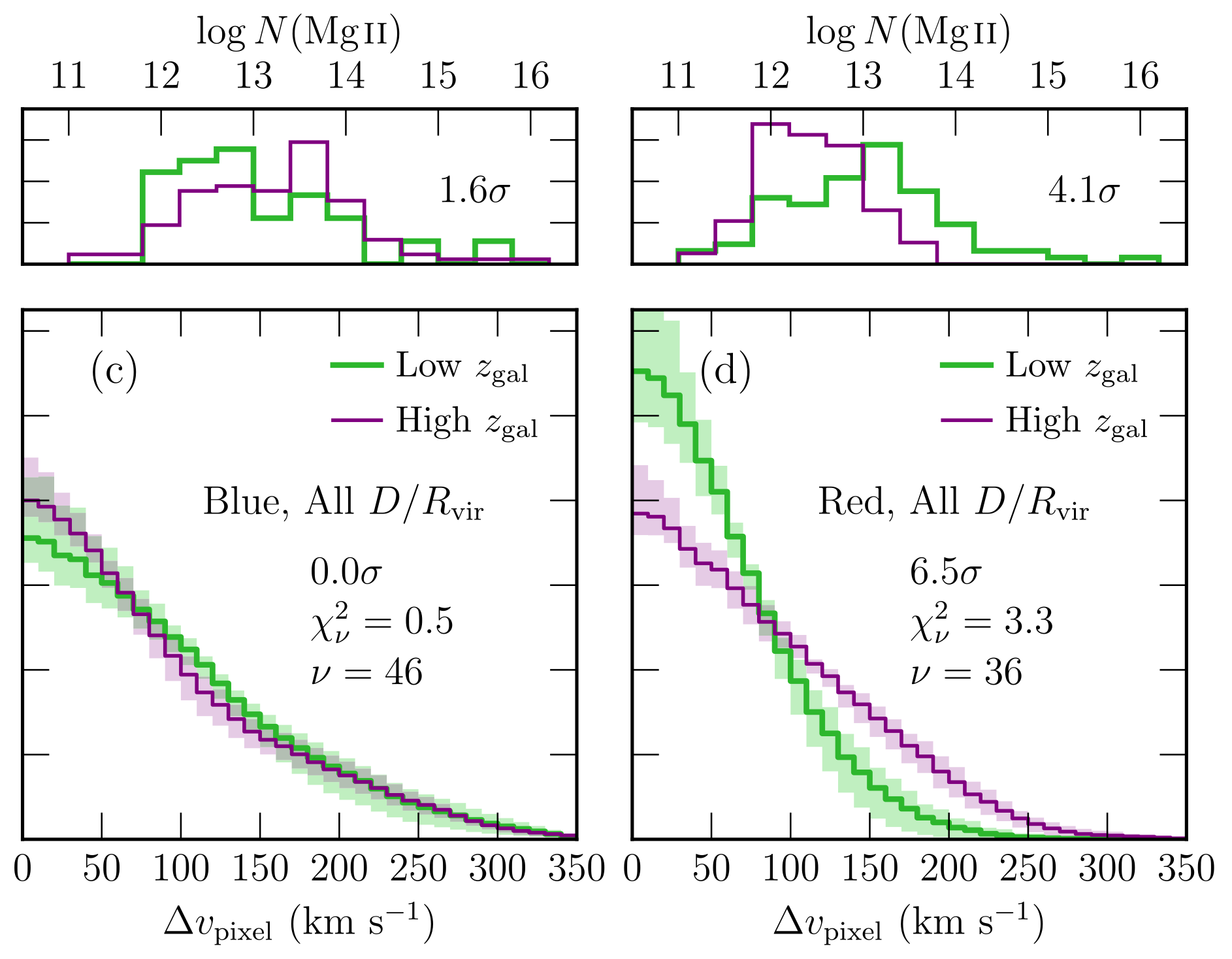
A subset of about 40 MAGIICAT absorbers (and an
additional 30 non-absorbers) have high-resolution
spectral coverage with HIRES/Keck and/or UVES/VLT. With
this sample, we studied the absorber kinematics and
column densities as a function of galaxy redshift and
impact parameter.
(Left) The kinematics and column densities for
absorbers associated with blue galaxies do not evolve
with redshift, indicating an active baryon cycle to
replenish the CGM with cool gas. For red galaxies, the
velocity dispersions decrease and column densities
increase with redshift. The CGM of red galaxies appears
to be impacted by star formation quenching.
Tracing Outflows and Accretion: A Bimodal Azimuthal
Dependence of MgII Absorption
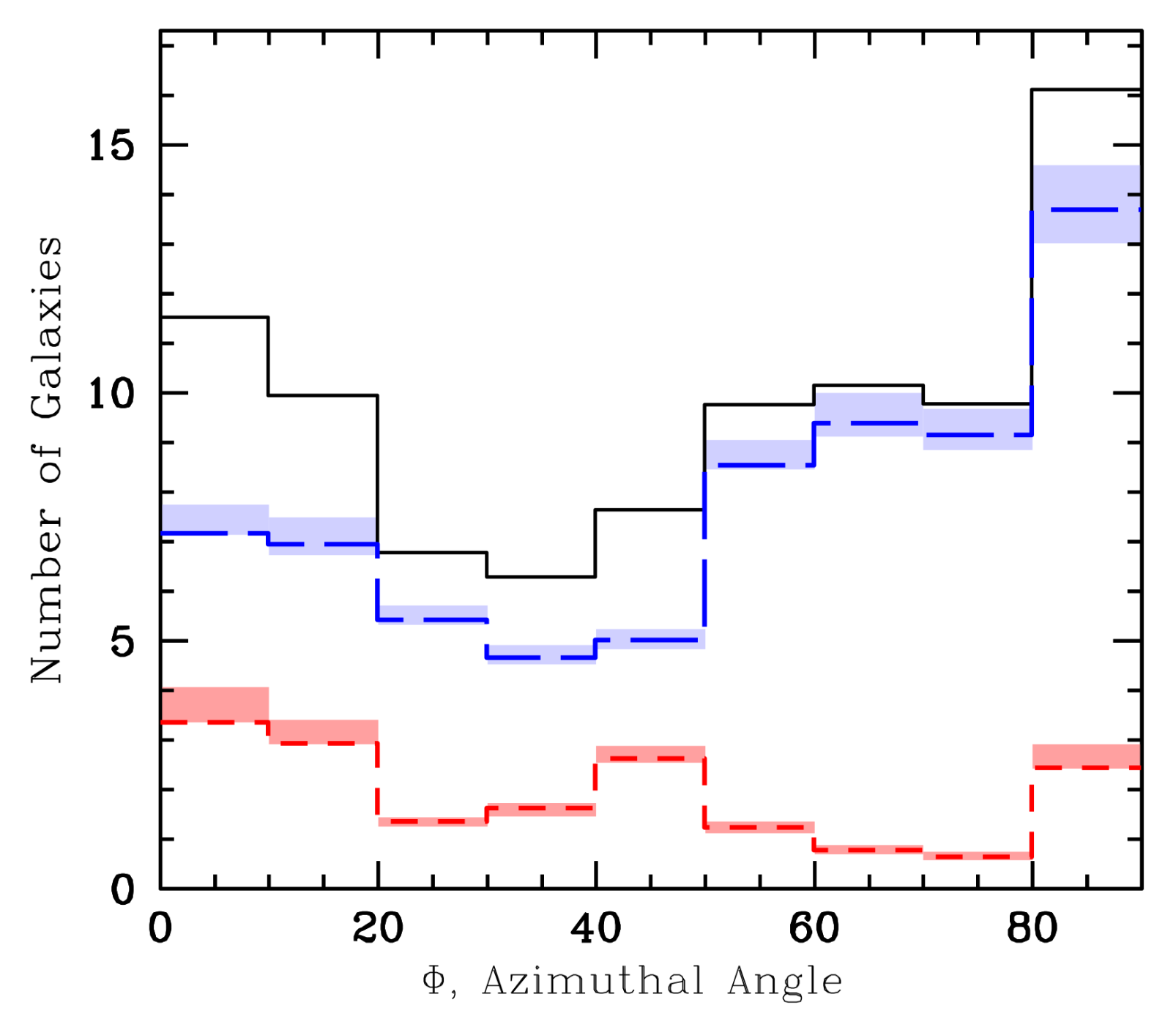
Galaxy morphological properties were modeled
from HST or SDSS images for 88 absorbing and 35
non-absorbing galaxies. We investigated the dependence
of MgII covering fractions on the azimuthal angle: the
angle between the projected galaxy major axis and the
quasar sightline. MgII absorption is more likely found
within 20° of the major axis and within 50° of
the minor axis.
(Right) The azimuthal angle dependence of MgII
is most strongly seen in blue star-forming galaxies,
whereas the distribution is flat for red passive
galaxies.
MAGIICAT V. Orientation of Outflows and Accretion
Determine the Kinematics and
Column Densities of the
Circumgalactic Medium
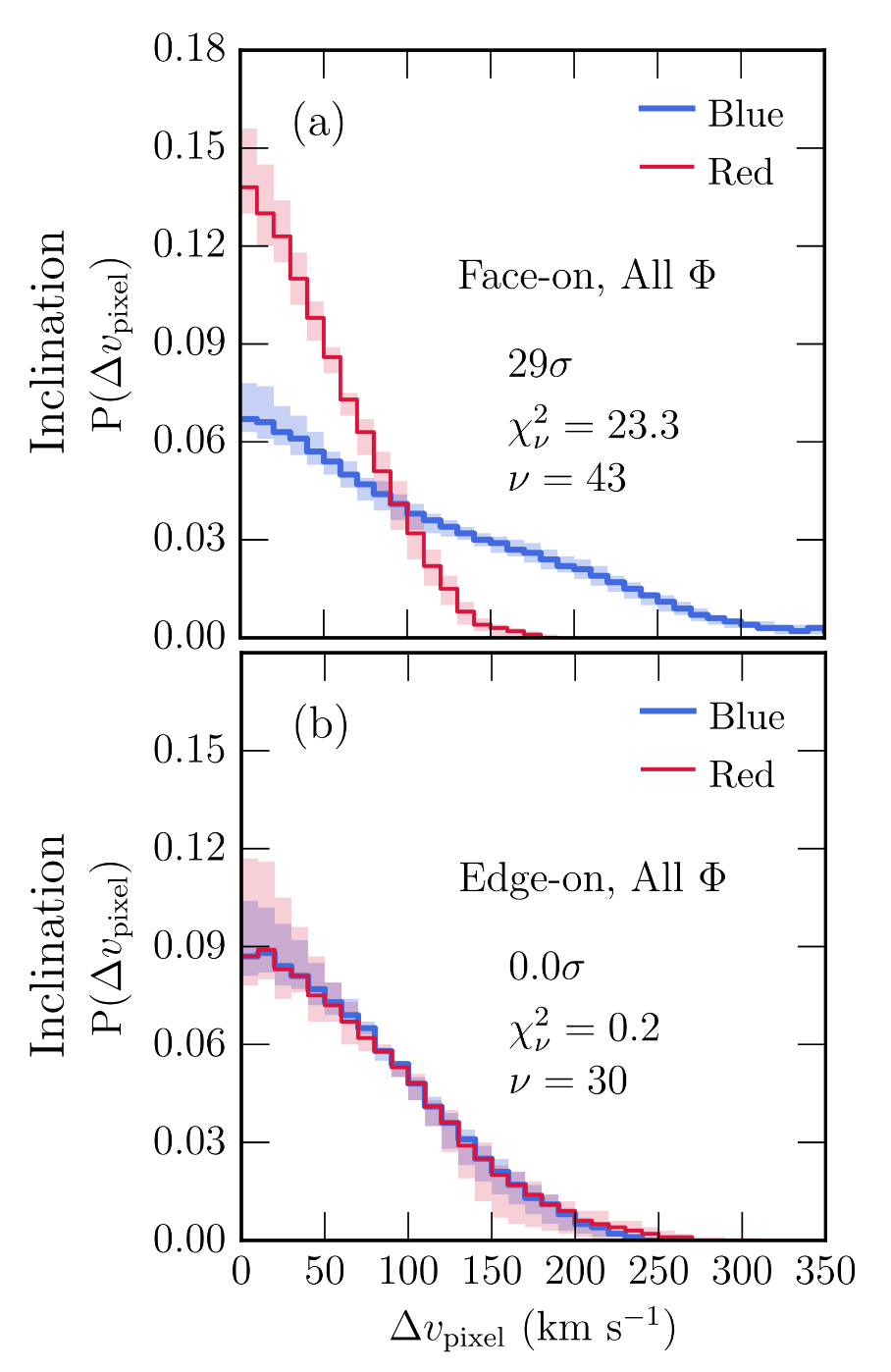
Baryon cycle processes are expected to exhibit differing
kinematic and column density properties depending on the
orientation of the host galaxy. We investigated these
differences for a sample of 30 galaxies with MgII in
high-resolution quasar spectra and modeled galaxy
morphologies (inclinations and azimuthal angles)
from HST images.
Gas entrained in biconical outflows along the
minor axis of star-forming galaxies appears to be
fragmented with large velocity
dispersions. Accreting/rotating gas along galaxy major
axes has smaller velocity dispersions and may be more
coherent. Quiescent galaxies appear to exhibit
little-to-no outflows along their minor axes, but may
host rotating gas along their major axes.
(Left) Absorbers hosted by blue, face-on
galaxies have the largest velocity dispersions,
indicative of outflows, whereas red, face-on galaxies
have the smallest velocity dispersions, suggesting a
lack of outflowing gas. For absorbers hosted by edge-on
galaxies, there are no significant differences in their
kinematics regardless of the host galaxy star formation
activity.
MAGIICAT VI. The MgII Intragroup Medium is
Kinematically Complex
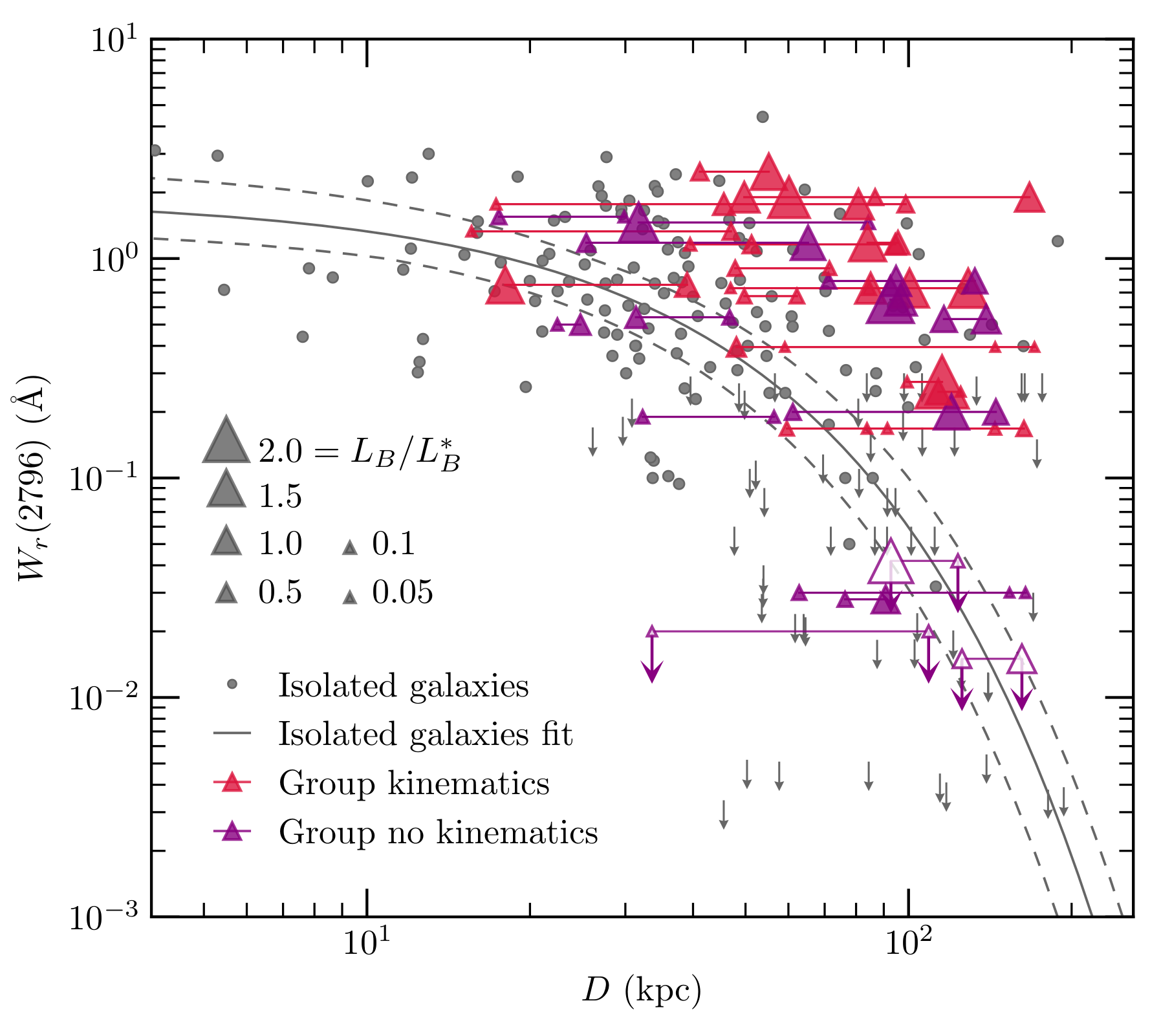

Working with a sample of 29 group environments
(2–5 galaxies within 200 kpc of the quasar
sightline and within a line-of-sight velocity separation
of 500 km s-1), we examined the MgII
intragroup medium. A superposition of multiple galaxy
CGM predicts much of the observed equivalent width, but
greatly overpredicts the kinematics. MgII is likely
deposited into an intragroup medium via outflowing winds
and/or from tidal stripping of interacting member
galaxies.
(Right, top) Group environments, with connected
triangles, have larger median equivalent widths and
covering fractions than isolated galaxies, gray points
and downward arrows.
(Right, bottom) Comparing average absorption
profiles, group absorbers display more optical depth at
larger velocities (roughly 100 km s-1) than
isolated absorbers.













